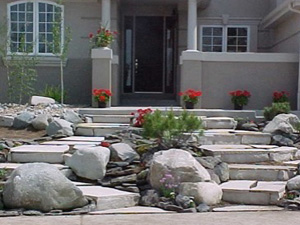Retaining wall and Patio walls
Walls are in intricate part of patio design; they serve both function as well as aesthetic. Rather your walls are holding back earth to support your house foundation, or they are decorative seating wall to span your firepit area, we can build it for you. Different types are walls are used for different purposes and each wall is specific to the slope of your yard at the point of the wall location or end of the patio.
Support Walls
Support walls are pretty typical for patios on new build homes, usually a 10-12” tall wall goes under the patio floor to create a level surface which is filled with a gravel base. These are built on a gravel footer and can integrate into seat walls or pillars and can have steps to the ground below. New homes are built with a slope, usually 1” per foot for the first 10’ or so, give or take, this can cause the need for a support wall even if your yard may feel flat when you are out there.
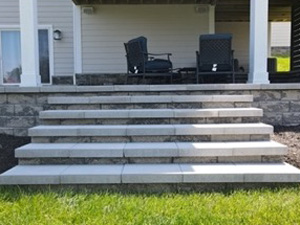

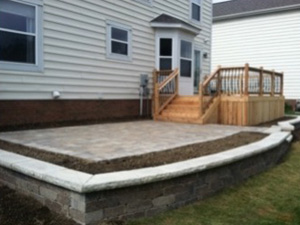
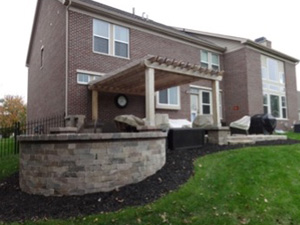
Seating Walls
Seating walls are even more common than support walls! Most patios feature a seat wall, it gives a convenient place to sit, gives height to the patio and will help to define the areas. The most common seat wall is Brussels Dimension Seat wall, we build it 5 stones high -including the cap- above the patio floor. The standard cap is a Brussels 8x4x12 turned perpendicular to the running wall. The cap can be upgraded with a couple suitable options- Bullnose concrete pavers or a Ledgestone, also known sometimes as Indiana Cap or Natural Stone cap. More on caps later- here’s some examples of BD Walls that we have built. Notice the accent row, it usually matches the paver floor border. It’s complimentary with our wall install but we can leave it out if you prefer a solid color wall stone.
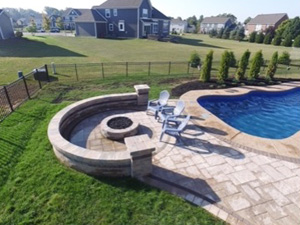
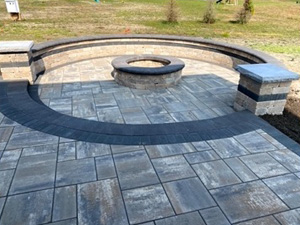
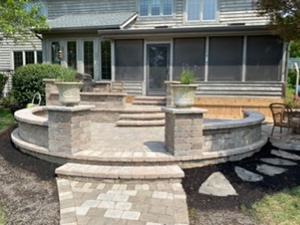
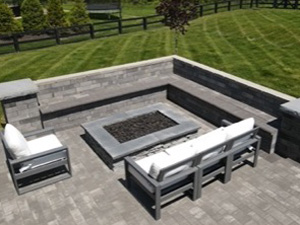
Veneer Stone Walls
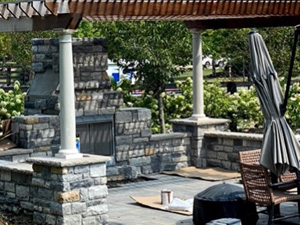 Veneer stone seating walls are another great option! These walls are built on a gravel footer (for typical height walls) using Cinderblock, 8x8x16 so the wall height ends up being a couple inches higher than the BD wall mentioned above. The cap on these walls us typically the upgraded limestone/Indiana cap but there are a couple different options as well. Here are a few examples of veneer stone walls we’ve installed. These types of walls tend to get paired with a Natural Stone or Travertine patio versus the concrete paver patio however, we have also used veneer stone with standard pavers and matched them to the house veneer stone. We match all products to the house as best as possible!
Veneer stone seating walls are another great option! These walls are built on a gravel footer (for typical height walls) using Cinderblock, 8x8x16 so the wall height ends up being a couple inches higher than the BD wall mentioned above. The cap on these walls us typically the upgraded limestone/Indiana cap but there are a couple different options as well. Here are a few examples of veneer stone walls we’ve installed. These types of walls tend to get paired with a Natural Stone or Travertine patio versus the concrete paver patio however, we have also used veneer stone with standard pavers and matched them to the house veneer stone. We match all products to the house as best as possible!
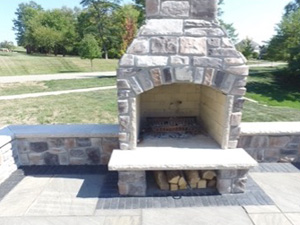
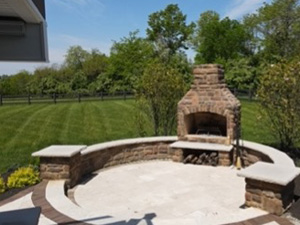
Retaining Walls
Retaining walls are also support walls in a way, support walls are “retaining” but these are typically mentioned when referring to holding back a landscape, either the ground that is cut in for a driveway area, used to terrace a yard with a steep grade, or can be built on the side of a valley and incorporate steps. There are a lot of different uses for retaining walls and a lot of different products to use for them. While we don’t specialize in retaining walls, they are a part of hardscaping that we do from time to time. Different material options include Unilock Pisa 2 stones, outcropping with large flat boulders and there are also some concrete formed options of outcropping.
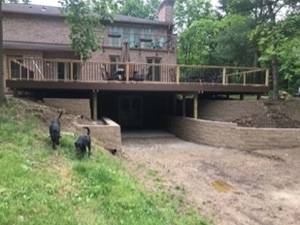
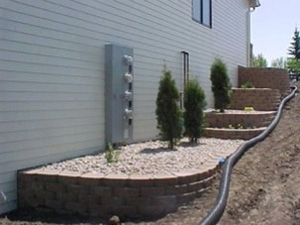
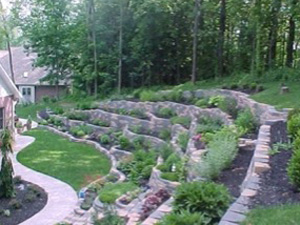
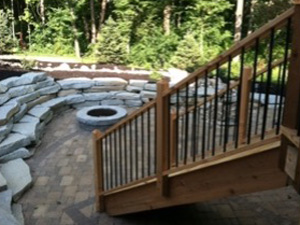
Support Walls with Seating Walls
Sometimes we use support walls in combination with seating wall. This can be done using the same product all the way up the wall, or you can split up the wall with 2 complimentary paver selections, like Pisa 2 and Brussels Seating wall. Both Unilock Wall Stones come in the same or similar colors. It can be a smooth transition from one wall to the next or there can be a separation with a cap or paver stone between.
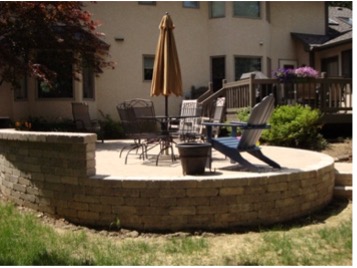
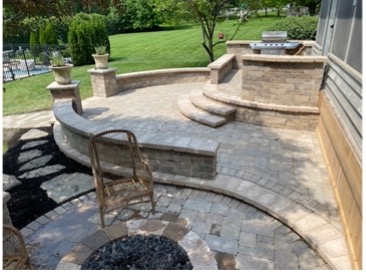
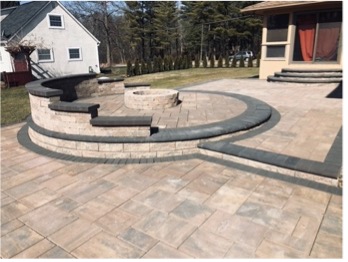
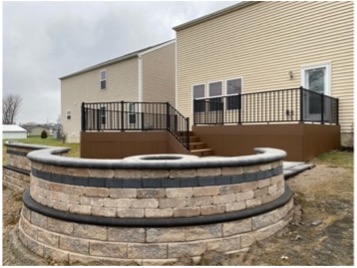
Natural Stone Walls
We can use natural stone for any of the applications we talked about before using concrete pavers. Here are a few examples of Natural Stone walls. They can be used to retain, sit, and define landscape beds just like Dimensional concrete stones but add a bit of natural beauty to your yard. There are even times that we mix these with standard paver stone floors as well.
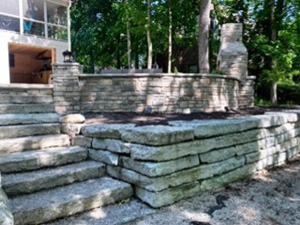
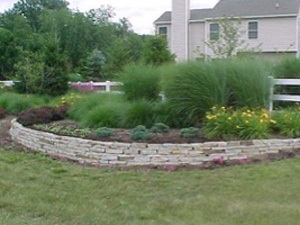
Wall planning and construction is largely impacted by the grade of the area and the accompanying landscapes. This makes each wall job unique which is why there is not any standard wall pricing on our Budget Guide page. Often Steps are needed to access the areas once we separate them with steps. Here are a few examples of how we would work steps into your retaining or support walls.
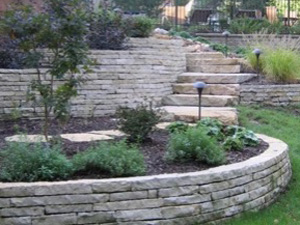
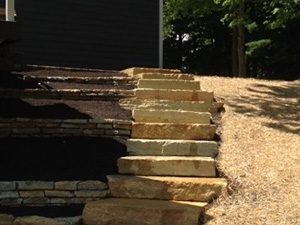
Sometimes walls are not quite enough for the grade that is present, maybe a deck would be a better option for these types are areas. We install decks too, if you need some expert advice on rather or not a deck or patio suits your Outdoor Living space give us a call to set up a free estimate. We offer a 5 year warranty on workmanship, settling and patio function so we are not going to build a retaining wall patio for you unless it is going to stand the test of time. Build it right the first time with us!
